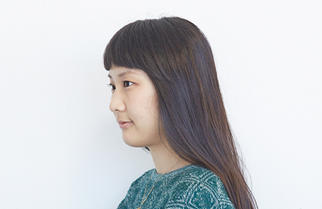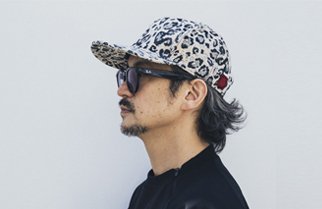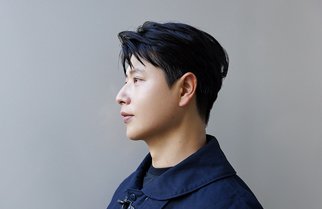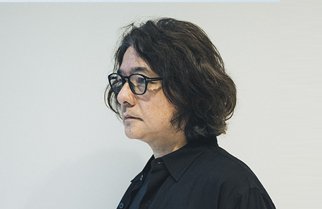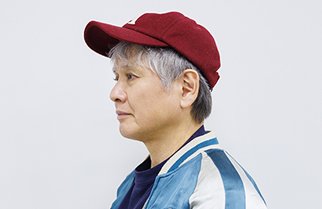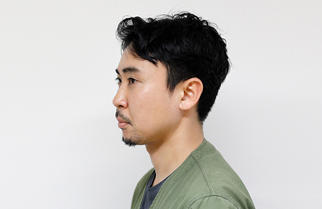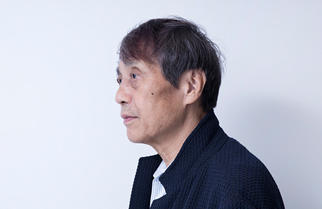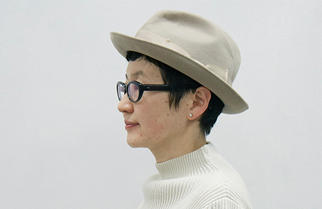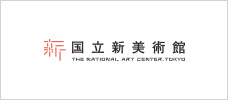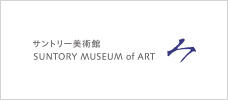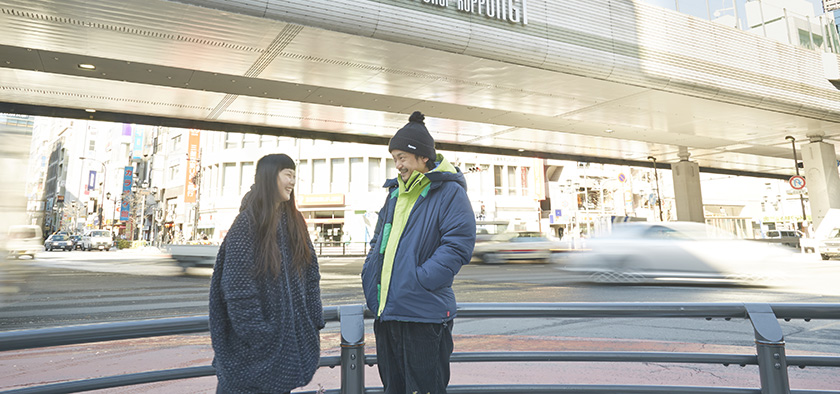
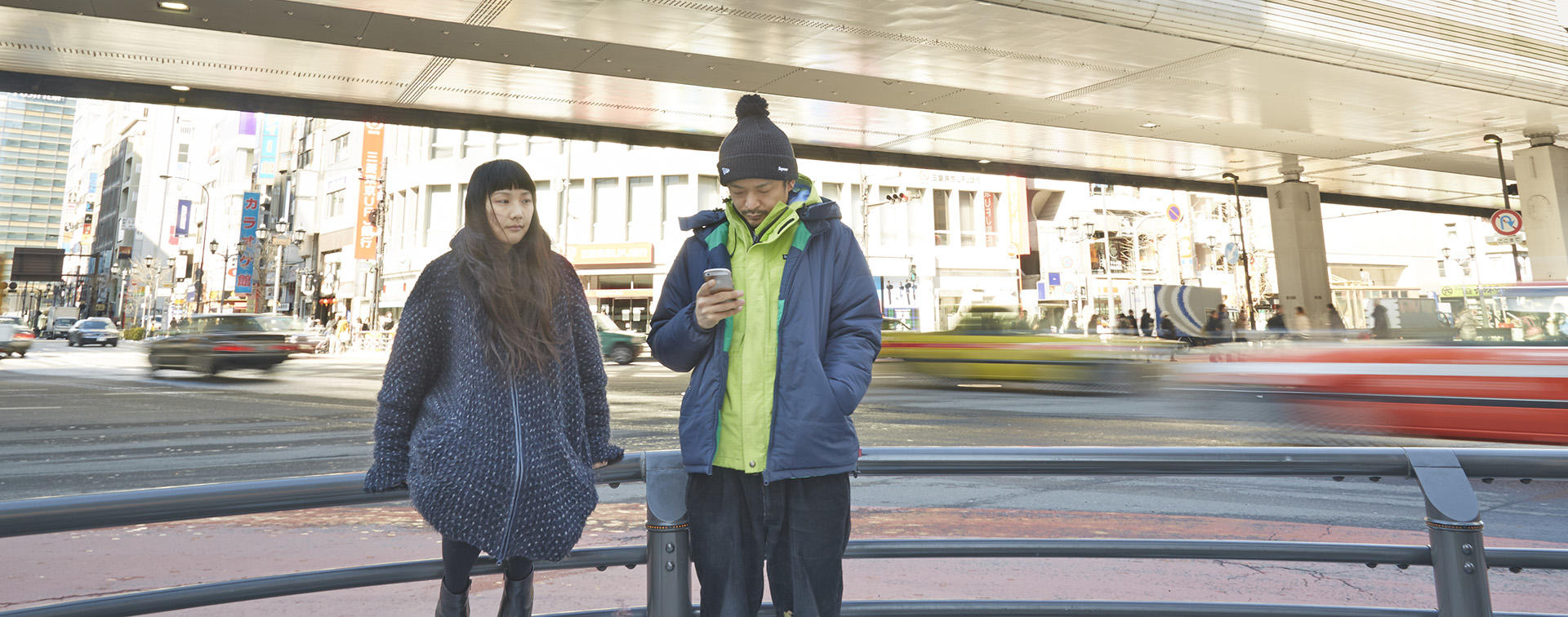
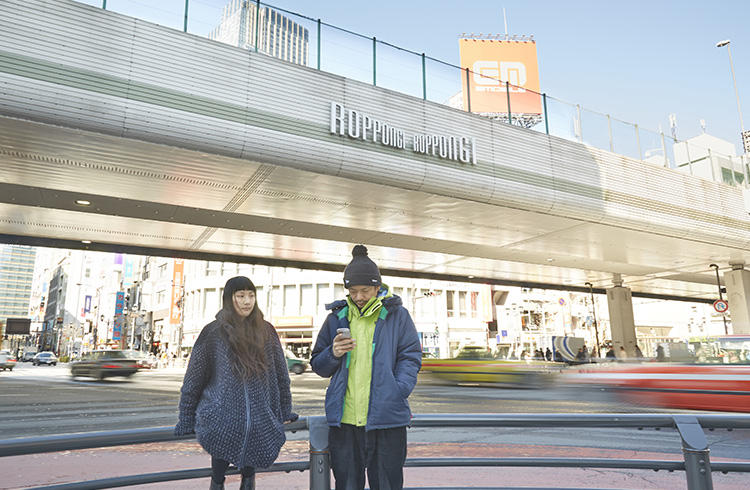
Roppongi should actively transmit not only information but also culture
Roppongi is not for children Giving oneself enough space to think
On February 16, an event dubbed "Midtown Design & Art Live" was held at the atrium of Tokyo Midtown. As part of this event, a talk show was held with media artist Daito Manabe and sound artist Mari Ohno as guests. Manabe is a media artist known for directing the website of Perfume - the Japanese pop band - while Ohno is a sound artist who makes sound effects and installations. At the beginning of the talk show, photos of the works made by the two artists were shown to the audience.
Similar motifs, different output
Daito Manabe (hereafter Manabe) This is a photo of a work called "electric stimulus to face". It's an experiment that involves sending electric pulses to move the muscles of the face. A person holds in his hand a device called a myoelectric sensor which senses the faint electric currents emitted when the muscles contract. The strength of the currents sent to the face is manipulated so that when the right hand moves, the muscles around the left eye move, while movements of the left hand lead to muscles movements around the right eye.
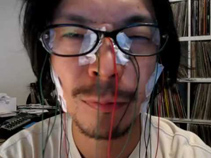
electric stimulus to face
A short film made in 2008 and released on YouTube. An experimental work to manipulate facial expressions using electric signals, it led to Manabe getting worldwide attention. The movie has been played more than 1.75 million times.
Mari Ohno (hereafter Ohno)Ah, that's how it works.
ManabeWhen I was making this, I had plenty of time on my hands, so I was putting my energy into this kind of thing every night. (laughs) Before this, I had made a device for contemporary dancers which could be attached to their bodies and which transformed their movements into sound. It made me want to make something similar for myself, and since I'm not a dancer, I thought that I could use my facial muscles.
OhnoA work of mine "bio effector" also uses a sensor. When you put your hand over the sensor, the sound of blood flow is detected and reflected as vibrations on a sheet. The sheet's vibrations are controlled by a monitor and the sounds are changed by changing the tension of the sheet. I wanted to make something that expressed the parts of the body which normally cannot be perceived; I wanted to make people feel as if they had gone inside their own bodies.
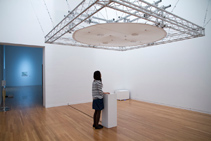
bio effector
A work by Mari Ohno and Kosuke Nagata. The sound of blood flow of a person is used to oscillate a sheet hung in a room. The tension of the sheet is changed to give off different sounds, like a string on a musical instrument. The installation was exhibited at the Museum of Contemporary Art Tokyo in 2013.
ManabeYour works also incorporate human bodies and elements such as low-frequency waves, and have three-dimensional and architectural aspects. I think our works have similar motifs but it's interesting that our output is different.
OhnoI once helped to organize one of your events. It was a job at the very bottom-of-the-ladder (laughs) but I was able to learn a lot.
Spending time on self-initiated projects
ManabeI often get ideas for works when I am in the shower.
OhnoI don't do anything particular either to come up with ideas. I just keep doing whatever interests me. Incidentally, what motivates you to make your works?
ManabeSometimes I'm asked to make something, and sometimes I just want to do a project, so it's either by request or self-initiated. Even when there are no requests, I'm usually doing various experiments, and accumulating experience. When I'm doing my own projects, I can afford to make mistakes and set my own goals. For instance, that face stimulus device wasn't an assignment, and there were no plans to release it but I just kept on making it. Then thanks to YouTube, I began to get offers from people.
OhnoI'm now spending many hours on things that might have no use for anything. But in addition to satisfying my curiosity, I do hope that I can eventually make something that will be useful for people...
ManabeWhen you become busy with work, it becomes harder to do that, so it's important to set aside time for yourself. I sometimes go abroad - to Europe for example, so that I can shut out the noise and concentrate on creating things. I think that in that sense, self-initiated projects are hard to carry out.
OhnoI start making experiments whenever something catches my interest. I'm always wondering about what kind of results I would get if I did so and so. I have enough time on my hands to do that. (laughs) Right now I have around 100 projects I would like to do if it were not for obstacles such as budget and place.

Thinking about works for Roppongi
ManabeThe theme of today's talks is "The future of Roppongi and design and art." I think Roppongi is a good place for people who do fieldwork when making their works. But what matters more to me is people rather than place. That's because my works start with people such as performers and dancers...I suppose it must be the same for you too, Ohno-san, since you use data on human bodies to make your works.
OhnoYes. Few of my works are town-oriented. I try to express myself mainly through sounds, and that's why I have more interest in the characteristics and temperature of a certain space or environment rather than in the town itself.
ManabeAt my company Rhizomatiks, when we make installations for towns, we sometimes put in hidden commands that let us to sort of leave our mark. For example, we made the system for the "Melodystep" stairs in Sony building in Ginza; when you use the stairs, a note from the musical scale is sounded and a lamp is lighted with each step. We added a command to this system so that when the very top of the stairs is stepped on for the 30th time, a special pattern is set off.
Melodystep
A flight of stairs in Sony Building between the first floor and basement which lights up and emits sounds when a person walks on it. Manabe was engaged in developing the system for the stairs during the renovation made in 2006. The lights and sounds have been programmed to change depending on how people walk on the steps. For example, when the very top or the very bottom of the stairs has been stepped on for the 30th consecutive time, an "arpeggio" pattern is set off.
Sometimes when I walk the streets, I notice things like the tiles on the ground. I think to myself, "They seem be randomly placed, but maybe there's a hidden pattern here," and I get into a mystery-solving mode.
Artwork that use data and height difference
ManabeWorks I've recently made include visuals based on accumulated and analyzed data. I've also made software that can automatically create rap music. Incidentally, buildings such this building are filled with sensors. There are probably tons of surveillance cameras and microphones, and when you go out into the streets, ultrasonic sound waves are being emitted here and there to drive away mice.
Huge amounts of data are currently being used for proper purposes like security, but my area of expertise is doing something different with that kind of massive data to make new things. So I would be keen to do something in Roppongi in the genre of art, making use of such data.
OhnoI use technology as a tool to perceive nature and humans, so I'm interested in the characteristics of the sounds in the streets. In Roppongi, the Oedo Line runs really deep underground, while the observation tower is very high. I think it would be interesting to make a work utilizing the sounds produced from the differences in height.
ManabeThat sounds like a project that would be possible only in Roppongi.
OhnoThis is not about art, but in World War II, a device that was like a long horn was made to discern the sounds of enemy airplanes. It's an example of making use of heights and sound. I don't think there is an artwork that uses the kind of height difference that exists in Roppongi, so I would like to make such an artwork here if it's feasible.
Why children should not come to Roppongi
OhnoWe have a question from the audience: "If you were to make works in Roppongi geared toward children, what kind of works would you make?"
ManabeIn the daytime, the sunlight is too bright and it's not possible to use projectors and lighting, so I think I would make robotic works. I've made some works for children in the past: the important thing when making things for children is to design an interface that works even when handled in a haphazard way. But I'm not sure if works [for children] are suitable for Roppongi.
OhnoRoppongi is a place which people visit for a certain purpose - to do shopping or to look at art. It's a place where people are passive, and on the receiving end. So children shouldn't come to Roppongi. (laughs)
ManabeIf there was a specific need - such as providing a playing place for children while their parents are shopping, I think I could design or make something to meet that need. It's easier for me to come up with ideas when given actual conditions to work under, like perhaps making something for that skating spot (Diners Club International Ice Rink in Tokyo Midtown).
OhnoI think it's better for children to play in places where there is nothing so that they can develop their playing skills. Perhaps a desert would be better than Roppongi.
ManabeRoppongi is quite a tricky place, isn't it?
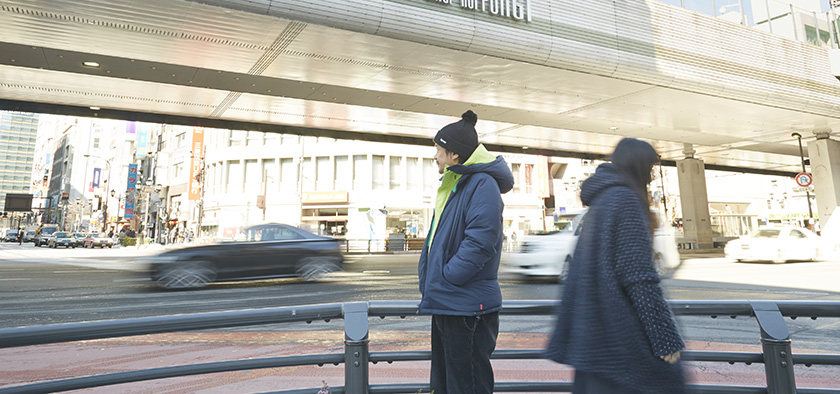
Finding it difficult to become friends with Roppongi
ManabeI was a DJ from age 18 to around 21, and during that time, I was in Roppongi almost every night. So Roppongi makes me think of clubs, music and nightlife. I used to drink with my father in a bar near here, and I lived in karaoke-boxes. I was quite a pathetic person. (laughs) How about you, Ohno-san?
OhnoThe first time I came here was around 10 years ago. I visited an exhibition at the Mori Art Museum which had just been built at Roppongi Hills, so my relationship with Roppongi isn't that long.
ManabeI used to come here a lot before Roppongi Hills was built, so we've been here at different times. After the construction of Roppongi Hills and Tokyo Midtown, the area of Roppongi was totally changed.
OhnoI was born and raised in Tokyo, but when I come here, I feel as if I've come to Tokyo from an outside region. Roppongi is slightly different from the Tokyo I know - it's a sophisticated place. Not many people seem to live here. I often come here for art events, but I find it quite difficult to become friends with Roppongi.
ManabeThe area has certainly become polished and the atmosphere has changed. That can be both positive and negative, depending on how you look at it.
OhnoIt's a nice-looking area, but I feel as if I can't open my heart to Roppongi despite our many encounters... Maybe we could become friends if we could be more frank with each other, but to me, the walls of Roppongi are thick. Nonetheless, there must be something behind those walls which I can have empathy for.
Creating residences and laboratories for artists
ManabeYou said you want Roppongi to show you what it has behind its walls, but from the perspective of art, I don't think that Roppongi has substance. It seems as if most of the works on display here were not created in Roppongi - they are works made overseas or in another place in Japan.
OhnoSo you are saying that Roppongi is where people come to work and or do activities like appreciate art, but that it's not a place where things are created?
ManabeYes. I've made an installation for Suruga Bank's "d-labo" and I've done live performances at Roppongi Art Night where people gathered in the evenings to look at art. During that event, Roppongi looked different from usual and there was a distinctive atmosphere of freedom and fun. But I don't think Roppongi is really a place for making things and transmitting information about them.
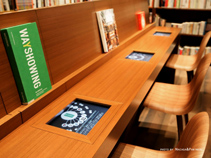
d-labo -Hyper Library-
A library inside the "d-labo" communication space next to the Tokyo Midtown branch of Suruga Bank. Rhizomatiks was in charge of designing the interface and programming for the library system. When a book is placed on the bookstand, the tag attached to the book cover is read, and information on similar-themed books is displayed on a touch panel screen.
OhnoRoppongi has many art museums and it's equipped with everything necessary to appreciate art, but it has no residences where artists from around the world can stay to make artworks. In the genre of media art, the Center for Art and Media in Karlsruhe, Germany and the Ars Electronica Center in Linz, Austria have research facilities attached to the art museums and art galleries where artists can work. I wish there were such residences in Roppongi.
ManabeThere are such facilities in Paris and New York. A similar place in Tokyo would be Tokyo Wonder Site. It certainly would be good if Roppongi could transmit more culture.
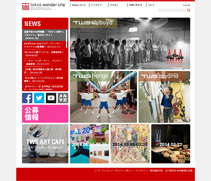
Tokyo Wonder Site
An art center set up by the Tokyo metropolitan government with the aim of discovering and supporting young creators. There are three facilities in Hongo, Shibuya and Aoyama where exhibitions and workshops are held, and where creators make works in the studios. The exhibitions include "Tokyo Wonder Wall" which exhibits works selected from the general public. The facility in Aoyama is equipped with accommodation and offers a creator-in-residence program.
OhnoAt such residences, artists can make artwork by interacting with all kinds of people and being influenced in many different ways. I think there are some things that you can only learn by living in a place.
Suddenly becoming good friends with Roppongi
ManabeRoppongi is a very convenient place, filled with information and services. That makes it all the harder for people to think for themselves. It kind of makes people passive, as you said earlier.
OhnoI myself only come to Roppongi when I have a set purpose, like looking at art. I suppose that in that sense, Roppongi's position has already been cemented.
ManabeJust like watching a Hollywood movie, you can stay passive when looking at things in Roppongi. But actually, artworks are not for passive appreciation. They may not be easy to understand, but they can be interpreted and enjoyed in many different ways. Some artworks may trigger the question, "Why on earth did the artist make this?"
OhnoIf artists want to make unfathomable works that have no practical use, I suppose they might as well make them in some place where there are no people... Nonetheless, if such works appeared in Roppongi, I would go, "Oh, I can relate to that!" and I think I might suddenly become very good friends with Roppongi.
Manabe(laughs) Of course, I like Hollywood movies and watch them, and there are times when I enjoy being at the receiving end of the kind of information that Roppongi relays. It's not a matter of whether something if positive or negative; people should choose things according to their moods. But I do think it would be nice if Roppongi could offer more unique site-specific fun.
Editor's thoughts
Manabe-san and Ohno san are acquaintances, and the talk show proceeded in a friendly atmosphere. No one would have guessed that Manabe-san had arrived only five minutes before the talk show and Ohno-san had been worried that if he did not show up, she would have to talk all by herself. At the last moment, Manabe-san had appeared, looking calm as if nothing was amiss. It would indeed be nice if the ideas that the two talked about become a reality. I hope that Ohno-san and everyone will become good friends with Roppongi.(edit_kentaro inoue)




